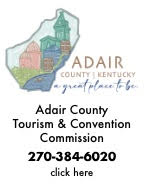| ||||||||||
Dr. Ronald P. Rogers CHIROPRACTOR Support for your body's natural healing capabilities 270-384-5554 Click here for details 


Columbia Gas Dept. GAS LEAK or GAS SMELL Contact Numbers 24 hrs/ 365 days 270-384-2006 or 9-1-1 Call before you dig Visit ColumbiaMagazine's Directory of Churches Addresses, times, phone numbers and more for churches in Adair County Find Great Stuff in ColumbiaMagazine's Classified Ads Antiques, Help Wanted, Autos, Real Estate, Legal Notices, More... 
|
Musings / ''Let's sing one of the Old Hymns,'' said disgruntled church member But age of hymnal is not always guide to age of its hymns By Joey N. Welsh Every pastor has heard the grumbling. Even if a church is intentional about using a mix of old and new hymns and praise songs, someone will remain dissatisfied until his or her "old favorite" is sung. For some people, a hymn qualifies as being "old" only if it is sung out of an aged, crumbling and out-of-print hymnal. Even if the very same piece is found printed in a newer hymnal, it only qualifies as a certified old hymn if it is sung from a decaying book. For many people, an "old hymn" means one that sprang from the 19th century revivals and camp meetings as well as the neo-orthodox music of the early 20th century written in response to the perceived threat of modernism in the church. For today, though, as we head from Palm Sunday into Holy Week and prepare to observe Maundy Thursday, Good Friday and Easter, I want to talk about another kind of "old hymn." And I mean really, majorly old, a hymn text that was written in Greek by an early church thinker and was ancient already before Columbus sailed or translators produced the King James Version of the Bible. Many songbooks contain an Easter hymn entitled "The Day of Resurrection." Set to a variety of tunes according to which hymnal is used, its words have been around for about 1300 years. I think it surely must qualify as an "old hymn." The text was written by John of Damascus (who lived from about A. D. 675 until around 749). He worked in the Greek language, the language in which the New Testament was first written for wide distribution. John was a major figure in the early centuries of Christian worship, and he wrote many texts for use on special days in the church year. Some of those texts have been translated into English, and we continue the traditions of the ages whenever we sing them. (Many hymnals include another Easter text he wrote, "Come, Ye Faithful, Raise the Strain") The words for "Day of Resurrection" and "Come, Ye Faithful" were both translated into English by John Mason Neale, a 19th century British clergyman who championed the revival of traditional texts, art and architectural styles in the life of the church. Besides his written texts for worship, John of Damascus was a defender of the use of paintings of Jesus and Mary - icons - as devotional tools in the early church, and he defended the decoration of sanctuaries with carvings and mosaics. Because of his defense of church-related art, John was sometimes referred to as "The Doctor of Christian Art." In the hymn "The Day of Resurrection" John sought to describe the joyous celebration of Easter, a religious festival that touched the hearts of believers very deeply. John Dahle edited a three volume commentary on church music back in 1928, The Library of Christian Hymns. In his book he described the coming of Easter at midnight after an all-day prayer vigil on Saturday, portraying the event as it would have occurred in Athens in the Middle Ages. He wrote: "The midnight hour is drawing near. The archbishop and the priests, together with the king and the queen, come out from the church and ascend a large platform from which they may be seen by the crowd. The people stand round about in silent expectation, reverently holding their torches which are ready to be lighted. A muffled song of the monks is heard from a distance. The firing of a cannon announces the midnight hour. The old archbishop raises the cross toward the heavens, and with a powerful and jubilant voice he exclaims: "Christos anesti!" (Christ is arisen!). The silence is broken by the triumphant shout of joy coming from the multitudes who repeat the grand message: "Christ is risen! Easter morn is breaking, darkness fades away!"This is how John of Damascus (as translated by John Mason Neale) sought to describe the joy of Easter 1300 years ago in his text that is truly a very, very old hymn: The day of resurrection! Earth, tell it out abroad;Have a happy and joyous Easter! And don't be shy about singing, whether your Easter favorites are very old or very new. The Joey N. Welsh is an anagram of a famous minister's name. It is the pseudonym of a Jefferson County pastor who served a very long tenure as pastor in a nearby South Central Kentucky town. He's agreed to share his column, "Musings," from time to time. This story was posted on 2006-04-09 01:00:00
Printable: this page is now automatically formatted for printing.
Have comments or corrections for this story? Use our contact form and let us know. More articles from topic News:
APRIL 2006 Birthdays: TODAY for SATURDAY, April 8, 2006 Burning controversy over name of red flowering bush brings letters from readers ACHS Band members spent spring break on tour of New York City APRIL 2006 Birthdays: TODAY for FRIDAY, April 7, 2006 States Abuse Reporting Hot Line is Tool to Protect Children APRIL 2006 Birthdays: TODAY for THURSDAY, April 6, 2006 Two treated at hospital following collision with horse CU to host Baptist Heritage Lecture Series Monday, April 10 Columbia/Adair County Firemen have busy Tuesday, April 4, 2006 APRIL 2006 Birthdays: TODAY for WEDNESDAY, April 5, 2006 View even more articles in topic News |



|
||||||||
|
| ||||||||||
|
Quick Links to Popular Features
Looking for a story or picture? Try our Photo Archive or our Stories Archive for all the information that's appeared on ColumbiaMagazine.com. | ||||||||||
|
Contact us: Columbia Magazine and columbiamagazine.com are published by Linda Waggener and Pen Waggener, PO Box 906, Columbia, KY 42728. Please use our contact page, or send questions about technical issues with this site to webmaster@columbiamagazine.com. All logos and trademarks used on this site are property of their respective owners. All comments remain the property and responsibility of their posters, all articles and photos remain the property of their creators, and all the rest is copyright 1995-Present by Columbia Magazine. Privacy policy: use of this site requires no sharing of information. Voluntarily shared information may be published and made available to the public on this site and/or stored electronically. Anonymous submissions will be subject to additional verification. Cookies are not required to use our site. However, if you have cookies enabled in your web browser, some of our advertisers may use cookies for interest-based advertising across multiple domains. For more information about third-party advertising, visit the NAI web privacy site.
| ||||||||||
















































